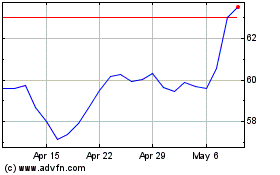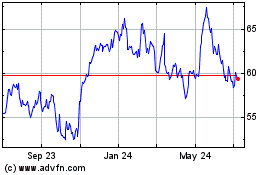By Jennifer Maloney
For years, U.S. sales of the cheapest beers fell as America's
two largest brewers focused on higher-priced craft brands. Now the
neglected suds are back in the spotlight.
Anheuser-Busch InBev SA on Sunday plans to air its first-ever
Super Bowl ad for Busch, its namesake economy brand. The 30-second
spot follows the company's move in 2016 to shift its Nascar
sponsorship back to Busch from Budweiser.
MillerCoors, the U.S. business unit of Molson Coors, has begun
rolling out new ads and redesigned logos for its economy beers,
including Miller High Life and Keystone. It is also increasing the
quantity of beer in some of its bottles and packages, without
raising prices. Both companies have been offering price promotions
on their cheaper brands.
Sales of so-called subpremium brews, which cost an average of
$16 for a 24-pack, have long been in decline. From 2010 to 2015,
shipments dropped by 16% to 46 million barrels, while shipments of
craft beers doubled to 22 million barrels, according to data
compiled by Beer Marketer's Insights.
But the subpremium category still represents roughly one out of
every five beers sold in the U.S. AB InBev and MillerCoors, which
together account for about two-thirds of the U.S. beer market by
volume, acknowledge they must stop the slide to achieve their
performance goals.
From consumer surveys, "one of the greater realizations that we
have is that as we prioritize other parts of our portfolio for all
the right reasons...we also did that at the expense of our economy
portfolio," said Ryan Marek, director of economy brands for
MillerCoors. "It's not only critical to our growth but critical to
the health of the entire beer industry."
After the merger of InBev NV and Anheuser-Busch Cos. in 2008,
the newly formed company began raising prices on its lowest-priced
beers more sharply than on premium beers, analysts and industry
observers said. MillerCoors did the same.
Those moves boosted revenue for a time but resulted in other
consequences as well: Some consumers switched to inexpensive
spirits, and the beer industry lost some of its most loyal
customers, since economy drinkers go on more beer runs than any
other group. Young people, for whom cheap brands might be a gateway
to a lifetime of beer consumption, increasingly turned to other
options.
"We've lost a generation," said beer-industry consultant Joe
Thompson, president of Independent Beverage Group. "And I think
we're going to pay a price for it."
The initiatives by MillerCoors and AB Inbev are starting to show
results. Economy volume fell only 1.6% in the 52-week period ended
Dec. 3, compared with a 3.6% decline in 2015, according to Danelle
Kosmal, vice president of Nielsen's Beverage Alcohol Practice.
Busch and Miller High Life sales have risen in recent months,
said Cowen analyst Vivien Azer, who credited price promotions for
the improvement.
Justin Pearce, 27 years old, switched to Busch from Miller Lite
last year when his neighborhood market began offering an 18-pack of
Busch for $8. The announcement that Busch would sponsor Nascar
after a nine-year absence from the races made him see the economy
brand in a new light, he said.
"For me, it went out of style when it left Nascar," Mr. Pearce
said. The Rhode Island resident picks up about two packs a month,
on his way to hang out with friends. On those occasions, though, he
is generally the only one drinking Busch, he said.
Marcel Marcondes, vice president of marketing at Anheuser-Busch,
said the company decided to feature Busch in the Super Bowl "to
give it a chance to grow faster" after the brand started to turn
around in the second half of 2016. "It's not a segment we can take
for granted," he said.
In the third quarter of 2016, AB Inbev's revenue fell 0.3% in
the U.S. market as volume dropped 2.5%.
In the Busch Super Bowl ad, developed by marketing firm Deutsch
New York, a flannel-clad man stands by a mountain stream and pulls
the tab on a can, releasing a "Buschhhhhh" sound that echoes
through the valley. The spot features a new design for Busch cans
being rolled out to stores this spring.
Anheuser-Busch declined to say how much it spent on the ad, but
Fox, which is broadcasting the Super Bowl this year, has been
asking advertisers to pay about $5 million for 30 seconds worth of
time. More than 100 million people are expected to tune in.
While MillerCoors isn't advertising during the big game, it has
been promoting the appeal, price or even alcohol content of several
of its economy brands.
In November, it revived the 1970s Miller High Life jingle "If
you've got the time, we've got the beer" in two TV spots, with
plans to air new commercials this year. It is also rolling out new
packaging or designs for low-price brands including Milwaukee's
Best and Keystone.
The packaging changes include bigger bottles -- 42 ounces,
instead of 40 ounces, for malt beverages -- and a 15-pack of
Keystone Light beer, up from a 12-pack, at the same prices as their
smaller predecessors. In an unusual move, MillerCoors bought
billboard ads to tout an increase in the alcohol content of
Milwaukee's Best Ice to 6.9% from 5.9%, another move intended to
highlight better value.
Write to Jennifer Maloney at jennifer.maloney@wsj.com
(END) Dow Jones Newswires
February 02, 2017 10:14 ET (15:14 GMT)
Copyright (c) 2017 Dow Jones & Company, Inc.
Anheuser Busch Inbev SA NV (NYSE:BUD)
Historical Stock Chart
From Mar 2024 to Apr 2024

Anheuser Busch Inbev SA NV (NYSE:BUD)
Historical Stock Chart
From Apr 2023 to Apr 2024
